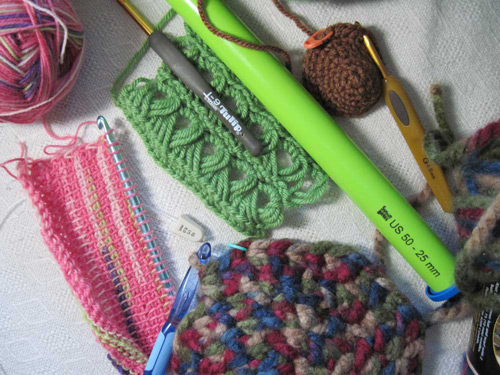Whether you prefer hooks or needles, one thing that can help you avoid repetitive stress injuries from your stitching is switching between projects. Not just on a day-to-day basis, but even an hourly basis.
We have all taken on a project that required hours of stitching a fairly mundane repeating pattern. For knitters, it is miles of stockinette or garter stitch without any shaping (can anyone say Dr. Who Scarf?). For crocheters, it can be that sweater made in fingering weight yarn with far too many rows of single crochet. The end results can be lovely, but it takes a LOOONG time to get there!
While projects like those can also be great “mindless” hand work for watching a movie or visiting with friends, they can also be a bit of a torture. Often they become the projects that we chain ourselves to until they are done. Otherwise, we are afraid that the project will become a UFO tucked away in a random corner of the basement or closet.
So we plod away at the project, promising ourselves that next time we will get to do something new and different and not miles of whatever stitch we are currently hunched over.
Actually, from a health standpoint, having a bit of “startitis” is a good thing. Having a variety of projects going at the same time is helpful.
Now this doesn’t mean you should only start projects and never finish them. I would never deny the joy of completing a project. It is a wonderful rush that every stitcher needs to experience at least once in a while. In fact, that is why I recommend doing some switching between projects-giving yourself a break from the big repetitive projects might actually help you finish more projects altogether!
Working a variety of projects that use different size hooks and yarns is the best bet. Switching between 2 different afghan projects with different stitch patterns worked in rows, worsted weight yarn, and the same size hook is not going to be that helpful. But switching between a broomstick lace scarf in ribbon yarn, a hat worked in the round in fingering weight yarn, and the earlier afghan can be great.
There are a numerous techniques in crochet that can really change things up too: Broomstick lace, Hairpin Lace, Tunisian crochet, Double stranded crochet, Tapestry crochet, Beaded crochet. As well as working with different yarn or hook gauges, even working in different fibers. All of these can make a change in your working rhythm, which is key to preventing repetitive stress injuries.
If you are one of those talented folks that can knit as well as crochet, even better. Switching between the 2 techniques can really change the hand and arm muscles that are doing the majority of the work. If you knit “continental” style the change might not be as dramatic, but there still is a shift as you are handling yarn with 2 needles instead of yarn with one hook.
Obviously, my primary rule still applies no matter what technique you are using. Listen to your Body and take Breaks, always a necessary step in keeping your body happily crafting. By switching your stitching you can give yourself mini-breaks and you may find yourself with more finished projects at the end.
